Let’s be honest: blogging has come a long way from the days of online diaries and food journal rants.
Today?
Blogging is a multi-billion dollar industry. It powers content marketing strategies, drives serious traffic, and helps people build businesses, personal brands, and loyal audiences — all from their laptops.
But here’s the catch:
Blogging in 2025 isn’t what it was even two years ago.
- AI tools are changing how we write.
- Reader behavior is shifting (hello, skimmers).
- And the competition? It’s fierce.
So… is blogging still worth it?
How many blogs are actually active right now?
Can you still make money blogging? Or is the gold rush over?
In this deep dive, you’ll discover the latest blogging statistics and emerging trends that matter — whether you’re a beginner, a seasoned blogger, or a content marketer trying to stay ahead of the curve.
Let’s break down the numbers and see where blogging really stands in 2025.
Real Blogging Statistics (2025)
How Many Blogs Exist?
- Over 600 million blogs currently exist worldwide.
– Source: WordPress.com - 1.9+ billion total websites, meaning ~1 in 3 is a blog.

Blog Posts Published Per Day and Year
- 7.5+ million blog posts are published daily (approx. 81 per second).
- That’s around 2.5+ billion posts per year.
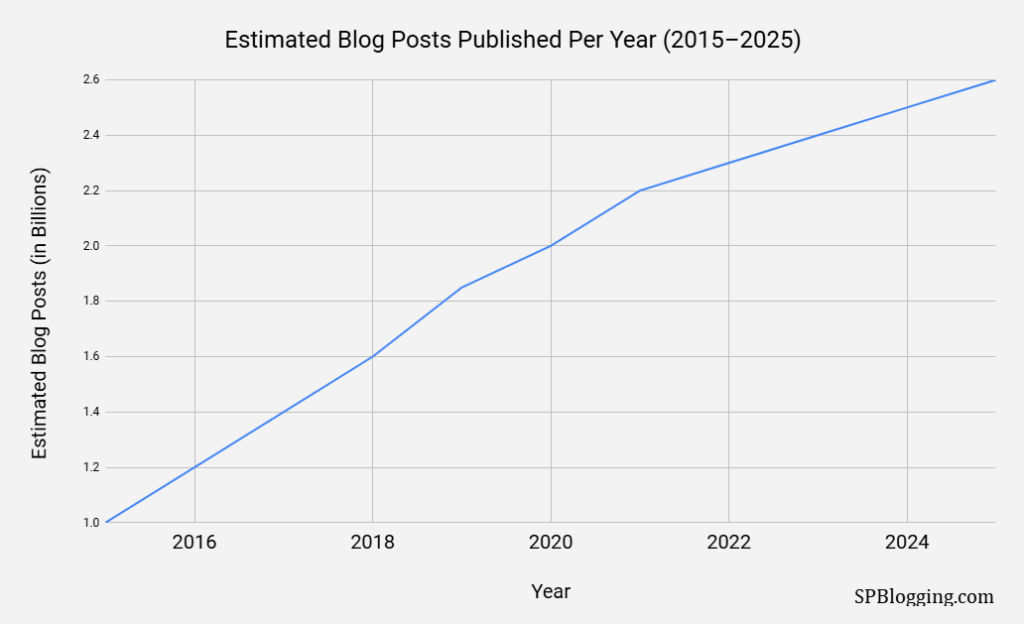
Platform Market Share
- WordPress powers 43.2% of all websites (as of mid-2025).
– Source: W3Techs
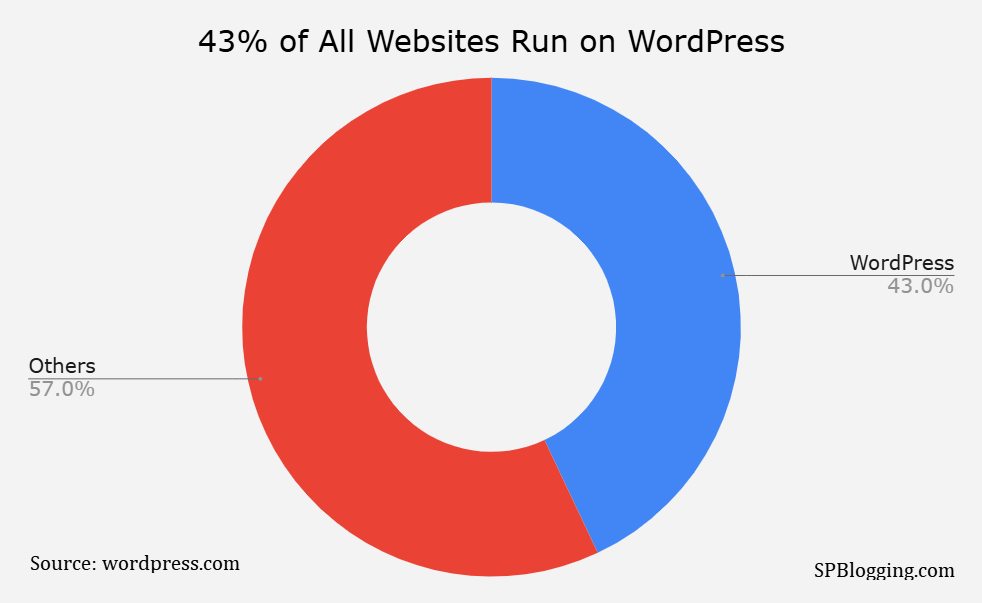
- WordPress blogs make up over 61% of all blogs globally.
- Other blogging platform shares (estimated):
- Shopify: ~6.7%
- Wix: ~5.4%
- Joomla, Drupal, Squarespace: All hovering below 4%
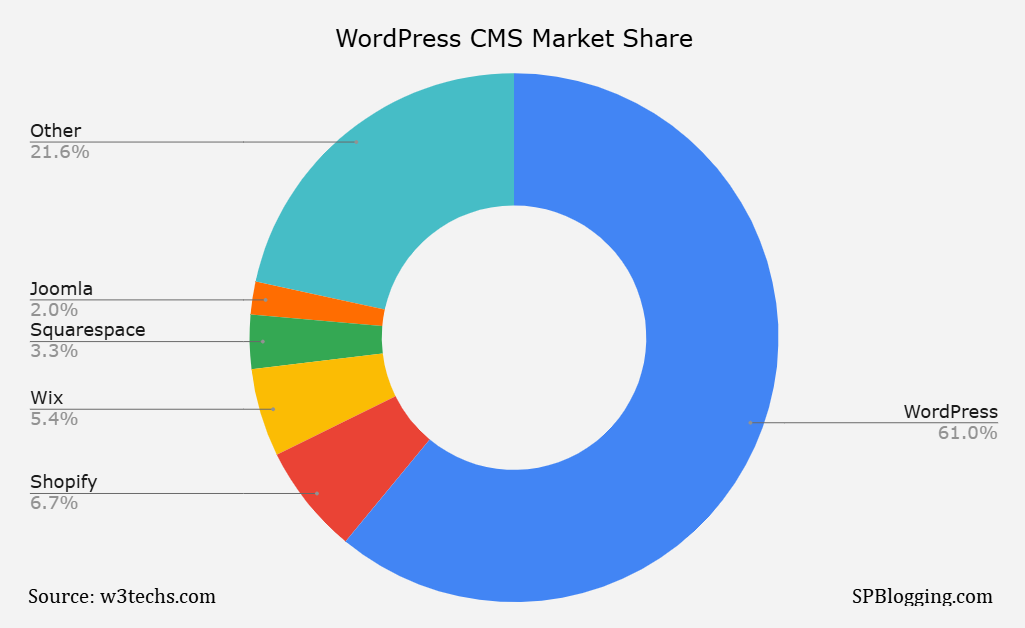
Top Blogging Countries
Here are the top 10 countries by number of active WordPress-powered websites—a strong proxy for active blogging presence—based on 2025 data from BuiltWith:
| Rank | Country | Active WP Sites (approx.) |
|---|---|---|
| 1 | United States | 3.6 million |
| 2 | Germany | 1.7 million |
| 3 | United Kingdom | 1.3 million |
| 4 | Brazil | 964 k |
| 5 | France | 934 k |
| 6 | Netherlands | 871 k |
| 7 | Italy | 856 k |
| 8 | Russia | 730 k |
| 9 | Japan | 697 k |
| 10 | India | 636 k |
Blogger Demographics
| Category | Statistic |
|---|---|
| Female Bloggers | ≈ 60–67 % |
| Male Bloggers | ≈ 33–40 % |
| Aged 21–44 | ≈ 50–60 % |
| Under 20 | ≈ 20 % |
| Over 50 | ≈ 7–14 % |
| Bachelor’s Degree | ≈ 60–78 % |
| Advanced Degree | 5–22 % (Master or PhD) |
| < $1k/year Income | ~40 % |
| $500–2k/month | ~30 % (when monetized) |
| > $100k/year | ~10 % of bloggers |
| Professional Bloggers | ~14 % |
| Creator Status | 47 % full-time, 43 % part-time, 10 % hobby |
Content Volume and Frequency
If you think blogging is slowing down… think again.
The internet is drowning in content — and most of it is blog posts.
Let’s break down the volume:
7.5+ million blog posts are published every single day
That’s more than 2.5 billion posts a year — and yes, that number is still climbing.
So if you feel like your blog post is getting buried, you’re not imagining it.
The competition is real.
What’s the average blog post length in 2025?
- The average blog post is now ~1,427 words long
(Source: Orbit Media’s Annual Blogging Survey) - That’s up from 808 words a decade ago.
Why the increase?
Because longer content tends to rank better, attract more backlinks, and keep readers engaged longer — when it’s actually useful.
But here’s the kicker:
Most readers still skim. So even if you’re writing 2,000-word monsters, formatting matters more than ever.
How often do bloggers publish?
- 22% of bloggers publish weekly
- 21% post multiple times per month
- And around 3% are posting daily (these are usually companies or SEO-driven blogs)
Pro tip: It’s not about publishing every day.
It’s about publishing consistently and delivering real value each time.
What niches post the most?
Based on industry research:
- News & Tech blogs have the highest posting frequency (often daily)
- Finance, SEO, and Marketing blogs usually publish weekly or bi-weekly
- Lifestyle and Travel blogs tend to post less frequently — but often with more visuals or storytelling
Bottom Line:
More content doesn’t mean better content.
In 2025, it’s about finding your sweet spot:
- Enough posts to stay relevant
- Deep enough to rank
- Engaging enough to keep readers coming back
💡 And if you’re not formatting your posts with headers, bullet points, and visuals?
You’re already losing.
Blogging for Business
Blogging isn’t just for creators anymore.
In 2025, blogging is a business weapon — and smart companies are using it to generate leads, boost visibility, and close sales on autopilot.
Here’s how the numbers stack up:
77% of internet users still read blogs regularly
(Source: HubSpot)
Yep, despite TikTok, YouTube Shorts, and endless scrolling — people still turn to blogs for trusted, in-depth info.
Businesses that blog generate 67% more leads than those that don’t
(Source: HubSpot)
Let that sink in.
You could be running the best product in the world, but if you’re not publishing useful, search-friendly content?
You’re basically invisible.
B2B vs B2C Blogging
- B2B companies focus on case studies, whitepapers, and long-form content to rank for keywords with $$$ intent.
- B2C brands (think fitness, beauty, lifestyle) go all in on how-tos, reviews, and trends to drive traffic and build loyalty.
Bottom line?
If you’re selling anything online — blogging isn’t optional. It’s the core engine of your content marketing funnel.
Blogging Fuels SEO, Email, and Social
One great blog post can be repurposed into:
- 3+ social media posts
- 1 email newsletter
- 1 YouTube video outline
- Multiple quote graphics
All from one solid piece of content.
So no — blogging isn’t just writing.
It’s leveraged distribution.
What the Pros Are Saying:
“Our blog is responsible for over 60% of our monthly inbound leads. It’s our most powerful marketing channel.”
— SaaS Marketing Director (Source: Orbit Media Survey)
Bottom Line:
Blogging works. Still.
But not the lazy kind.
In 2025, the brands winning with blogging are the ones who:
- Know their audience
- Rank for high-intent keywords
- And publish strategic, high-quality content — not fluff
Reader Behavior & Engagement
Let’s be real: people don’t read blog posts the way they used to.
They skim. They scroll. They bounce.
Unless — and this is a big unless — your content actually hooks them.
Here’s what the numbers say about how readers interact with blog content in 2025:
Average Time on a Blog Post: 55 seconds
Yep. Less than a minute.
That’s your window to earn their attention — or lose them forever.
Scroll Behavior
- Only 30% of readers scroll past the halfway mark
- Just 16% reach the end of an average blog post
So yeah — that 2,000-word beast you just wrote?
Most people won’t finish it unless it’s scannable, visual, and packed with value from the start.
Blog Layout and Formatting Matter — A LOT
The top-performing blogs:
- Use headings every 300 words
- Include images, lists, and quotes every 500 words
- Avoid walls of text like the plague
Readers don’t want to read — they want to extract value fast.
What Content Formats Perform Best?
According to Semrush survey:
- How-to guides and tutorials drive the most traffic
- Listicles get more social shares
- Case studies have higher conversion rates
- Opinion pieces boost engagement and comments
Mixing up your formats isn’t optional anymore — it’s strategy.
Mobile Behavior Is Dominant
- Over 65% of blog readers are on mobile
- And mobile users are 2x more likely to bounce if the blog isn’t responsive or fast-loading
(Source: Statista, Google Web Vitals)
So What Can You Do?
Here’s the no-fluff checklist for keeping readers hooked in 2025:
- Start with a killer hook (first 2–3 lines matter most)
- Break up text with subheadings, bullets, and visuals
- Add images, screenshots, or GIFs
- Optimize for mobile first
- Include clear CTAs and related content suggestions
Want your content to actually get read?
Stop writing for Google bots.
Start formatting for human brains.
Here’s a pie chart visualizing scroll behavior on blog posts in 2025:
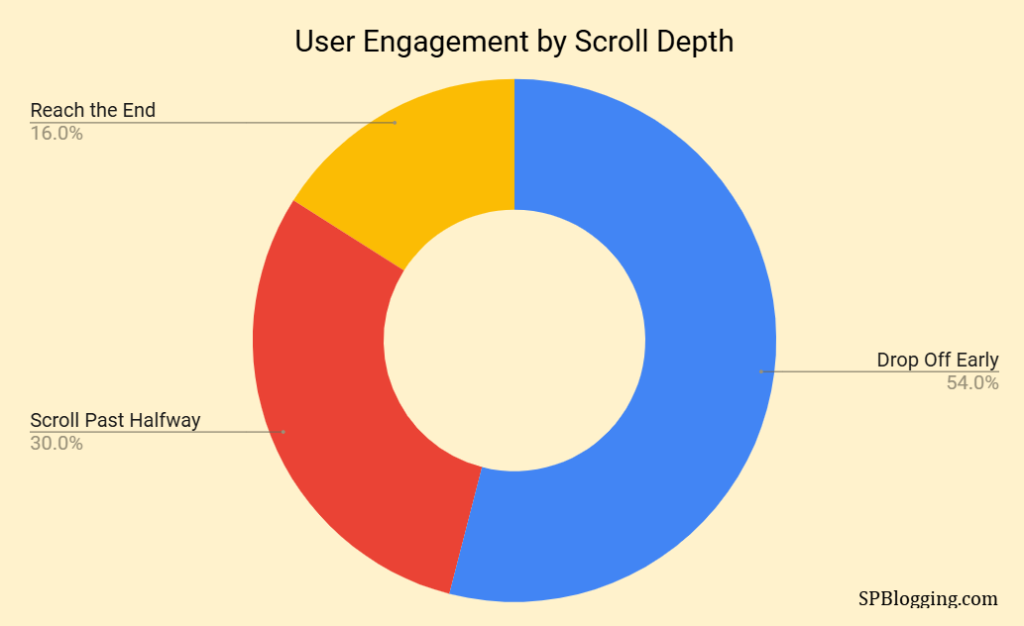
- Only 30% of readers scroll past halfway
- Just 16% make it to the end
- A whopping 54% drop off early
SEO and Blogging Trends in 2025
If you’re blogging without SEO in 2025, you’re basically shouting into the void.
Because here’s the truth:
Blogging and SEO aren’t just related — they’re married.
Let’s look at the trends and data that matter:
Organic Search = Blog Traffic Lifeline
- Over 68% of all blog traffic comes from search engines
And it’s not just Google anymore.
Bing, Brave Search, even AI chatbots — they all pull from optimized content.
If you’re not ranking, you’re invisible.
Keyword Research Is Non-Negotiable
Gone are the days of guessing keywords.
Top bloggers now:
- Use tools like Ahrefs, SEMrush, LowFruits, or Google Search Console
- Focus on search intent, not just volume
- Target long-tail keywords with low competition but high value
Example:
Instead of writing “best running shoes” → write “best running shoes for flat feet 2025”
Featured Snippets & Zero-Click Searches
- Over 50% of Google searches result in zero clicks
That means Google is answering questions inside the SERPs.
If you want to win:
- Use structured data (FAQ schema, how-to schema)
- Answer questions clearly and early in your content
- Optimize headers and bullet points for snippet grabs
Voice Search and AI Answers
Voice and AI tools now handle over 25% of all web searches.
So…
- Write in natural language
- Use question-based subheadings
- Structure answers in short, conversational paragraphs
Evergreen vs Trendy Content
Both work — but in different ways:
- Evergreen content (how-tos, tutorials, resource guides) drives long-term SEO traffic
- Trend-driven posts (2025 tools, AI trends, stats updates) bring short bursts of visibility and shares
Smart bloggers?
They do both — and update old posts quarterly.
What’s Working in 2025 SEO Blogging:
- Clear keyword targeting (1 main, 2–3 related)
- Internal linking like a boss
- Fast-loading pages (Core Web Vitals compliant)
- Mobile-first design
- Updating old content for freshness signals
Bottom Line:
SEO in 2025 isn’t about tricks or hacks.
It’s about being the best answer on the internet for a specific query.
If your content is better, faster, clearer — you’ll win.
If not? Someone else will.
Monetization: Can You Still Make Money Blogging?
Let’s address the elephant in the room: Is blogging still a reliable way to make money in 2025?
Short answer? Yes—but it’s not 2012 anymore.
You’re not going to slap a few Adsense banners on a blog post about “best protein shakes” and retire by the weekend.
But if you’re consistent, strategic, and treat your blog like a business? The revenue potential is very real.
What % of Bloggers Actually Make Money?
According to recent surveys, around 37% of bloggers make some form of income from their blogs.
But here’s the catch—only about 15% make a full-time income.
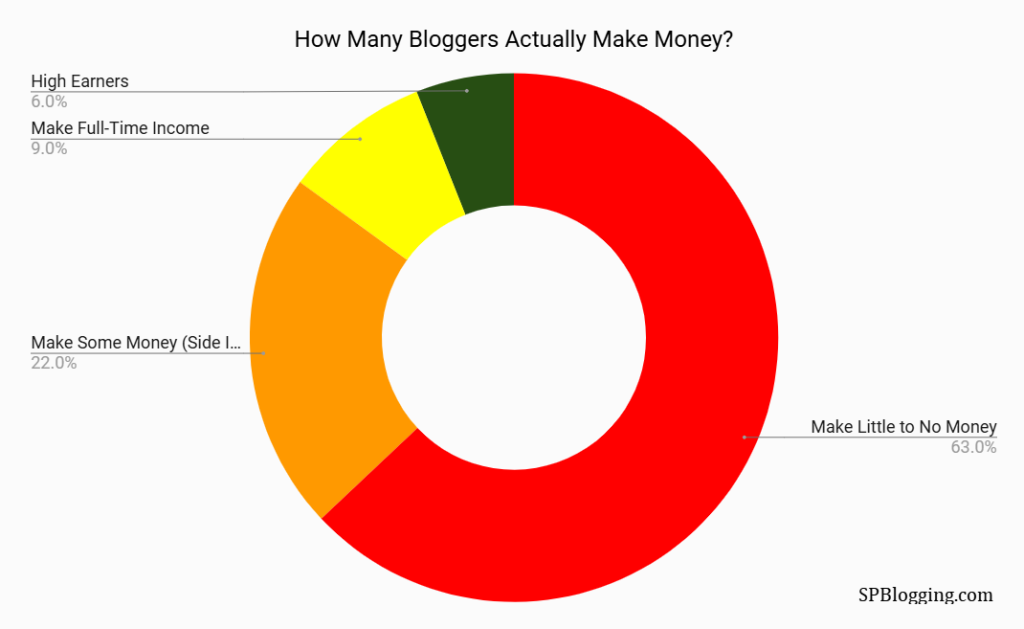
Why the huge gap?
Because most bloggers give up before they ever gain traction. The ones who do earn are typically:
- Laser-focused on a niche
- Consistent with content
- Smart with monetization
Where’s the Money Coming From?
Here’s a quick breakdown of the top monetization channels in 2025:
| Income Source | % of Monetized Bloggers Using It |
|---|---|
| Display Ads (AdSense, etc.) | 60–70 % |
| Affiliate Marketing | 50–60 % |
| Sponsored Posts | 35–45 % |
| Digital Products | 25–35 % |
| Online Courses | 20–30 % |
| Email Marketing (Newsletters) | 15–25 % |
| Services (Freelance/Coaching) | 20–30 % |
| Memberships/Subscriptions | 10–15 % |
| Physical Products | 10–15 % |
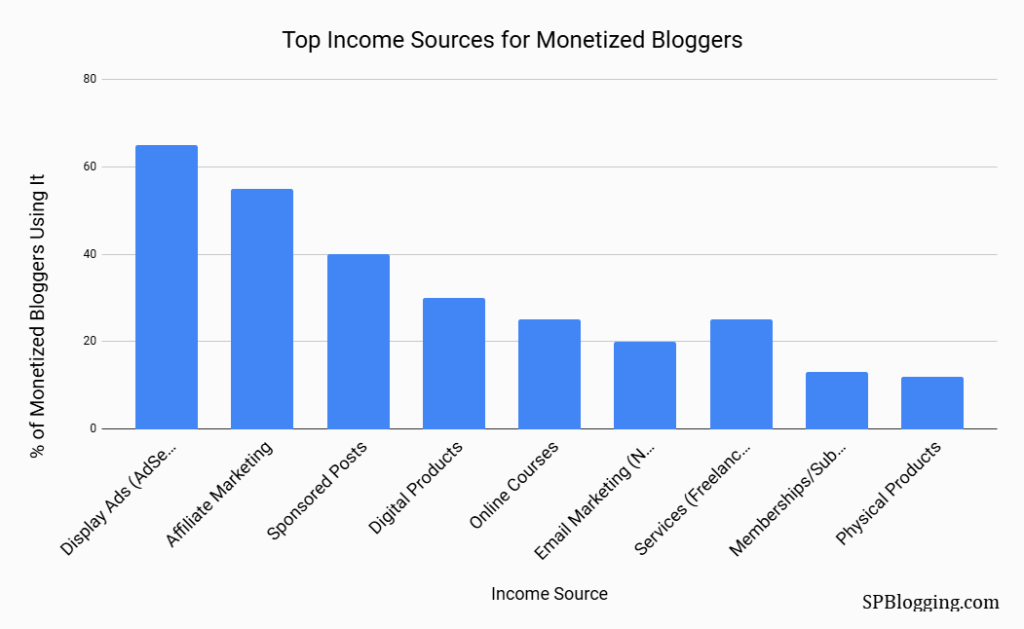
Notice something? Ads and affiliate marketing still dominate, but digital products and services are gaining fast.
Bloggers want more control over their income – and recurring revenue models are hot.
Income vs Traffic: What’s the Correlation?
There’s a pretty clear pattern: traffic = potential revenue, but only when monetization is set up correctly.
Here’s a very rough income estimate based on blog traffic (assuming solid monetization strategies):
| Monthly Traffic | Avg Monthly Income |
|---|---|
| < 10,000 visits | $0–$500 |
| 10k–50k visits | $500–$2,500 |
| 50k–100k visits | $2,500–$7,000 |
| 100k+ visits | $7,000–$20,000+ |
Of course, these vary wildly by niche. A finance blog with 20k visits could outperform a lifestyle blog with 100k.
Full-Time vs Part-Time Bloggers: Who’s Winning?
Roughly 23% of monetized bloggers go full-time, while the rest treat it as a side hustle or passion project.
- Full-time bloggers often create digital products, build email lists, and diversify income streams.
- Part-time bloggers typically rely more on ads and affiliate links—but still pull in respectable income.
And with AI tools like ChatGPT and SEO automation speeding up content production, we’re seeing more part-timers leveling up fast.
Bottom Line:
Yes, you can still make money blogging in 2025—but it takes work, strategy, and smart monetization. It’s not passive income. It’s performance-based income.
The bloggers winning today are those who treat their site like a real business, not a hobby.
Want to turn your blog into a revenue engine? Focus on traffic, pick the right monetization mix, and double down on what works.
AI and Blogging in 2025
AI isn’t the future of blogging anymore. It’s the present.
From writing outlines to drafting entire blog posts, AI tools have quietly (and not-so-quietly) embedded themselves in how content gets created today.
The big question now isn’t “Should bloggers use AI?” — it’s “How can they use it smarter than their competitors?”
How Many Bloggers Use AI in 2025?
Let’s talk numbers.
Recent data shows that over 60% of active bloggers use some form of AI writing tool—whether it’s ChatGPT, Jasper, Claude, or others. For high-volume publishers and SEO-focused bloggers, that number jumps to nearly 80%.
Why? Because AI helps them:
- Research faster
- Generate content ideas
- Speed up first drafts
- Rework and repurpose older posts
Think of it as a super-powered writing assistant that never sleeps (and doesn’t demand royalties).
Speed, Quality & Content Volume: What’s Changed?
Here’s what AI has changed in a blogger’s workflow:
| Factor | Pre-AI Era | With AI Tools (2025) |
|---|---|---|
| Avg. Draft Time | 4–6 hours/post | 1–2 hours/post |
| Posts per Month | 4–8 | 12–20+ |
| Editing Required | Medium | Still Medium (but faster) |
So yes—writing speed has improved dramatically. But the catch? Everyone has access to the same tools. Which means quality and uniqueness matter more than ever.
SEO Implications of AI-Generated Content
Google’s stance in 2025: AI-generated content isn’t the problem – low-quality content is.
The Helpful Content System now evaluates:
- Originality
- First-hand experience
- Depth and insight
- User engagement signals
So if your AI-generated blog sounds like a Wikipedia page run through a word spinner? You’ll struggle to rank.
But if you use AI to augment real experience, insight, and structure – you win.
And yes, AI content can still rank – as long as it’s genuinely helpful and adds unique value.
Will AI Replace Human Bloggers?
Let’s clear the air: AI is not coming for your blog. But it will replace bloggers who rely on copy-paste fluff and keyword-stuffing templates.
What AI can’t replicate (yet):
- First-hand stories and case studies
- Strong opinions and hot takes
- Personal brand voice
- Emotional nuance and humor
In other words, AI is a tool, not a writer. The best bloggers in 2025 are the ones who combine human creativity with AI efficiency.
Bottom Line:
AI is a game-changer—but only if you know how to play the game.
Use AI to write smarter, faster, and deeper – not just to pump out bland content at scale.
The future of blogging isn’t AI vs humans. It’s AI-augmented humans who win.
Trends to Watch in 2025 and Beyond
Blogging in 2025 doesn’t look like it did even two years ago—and it’s evolving faster than ever.
From AI-assisted writing to creators ditching traditional blogs for newsletters, the blogging landscape is shifting beneath our feet. If you want to stay ahead, these are the trends to keep an eye on.
1. Micro-Niche Blogging Is the New Goldmine
Generalist blogs? Tough game.
Bloggers in 2025 are drilling deep into micro-niches—think “vegan bodybuilding meal prep for travelers” instead of just “fitness” or “food.”
Why it works:
- Less competition
- Easier to build authority
- Attracts loyal, high-intent audiences
- Brands love to sponsor hyper-targeted content
Whether it’s parenting for twins, remote work in Europe, or sustainable dog products—depth beats breadth.
2. AI-Assisted Content Creation Becomes the Norm
As covered earlier, AI is no longer optional. But here’s the twist—the best bloggers aren’t just using AI to write blog posts.
They’re using it to:
- Build content calendars
- Generate SEO outlines
- Repurpose blog posts into tweets, scripts, and newsletters
- Research competitors and SERP gaps
AI is now a full-fledged content team in your pocket. Those who master prompt engineering and blend AI with originality? They’re moving faster, publishing more, and ranking higher.
3. Creator-Owned Newsletters vs Traditional Blogs
A quiet rebellion is happening—bloggers are turning their best ideas into newsletters.
Why?
Because email is:
- Algorithm-proof
- Highly personal
- Easy to monetize via subscriptions or sponsorships
Platforms like Substack, Beehiiv, and ConvertKit are empowering creators to build audience-first content ecosystems—without worrying about Google updates every other week.
The result:
Many successful bloggers are now newsletter-first, blog-second.
4. Rise of Audio Blogging & Video-First Content
Let’s face it—not everyone wants to read a 2,000-word article.
That’s why audio blogging (basically, mini podcasts) and video-first content (YouTube, Reels, Shorts) are booming.
In 2025:
- More bloggers are recording spoken versions of their posts
- Embedding short videos inside blog posts is now standard
- Tools like Descript and Riverside make audio/video creation seamless
If your content isn’t multimodal, you’re leaving reach on the table.
5. Community-First Content Is Gaining Momentum
A blog used to be a one-way street: you write, they read.
Now? It’s a conversation.
From private forums and Slack groups to Discord communities and comment-powered newsletters, bloggers are building tribes around their content.
Benefits of community-first blogging:
- Higher engagement and retention
- Direct feedback on what content to create
- Built-in launchpad for digital products and services
In 2025 and beyond, community is your moat.
Bottom Line:
Blogging isn’t dying—it’s evolving.
The best bloggers are adapting by going deeper, getting closer to their audience, and creating smarter with tech.
Stay nimble. Follow the data. And don’t be afraid to test what’s next.
Because the future of blogging?
It belongs to the creative, the focused, and the fearless.
Final Thoughts: Is Blogging Still Worth It in 2025?
Let’s cut to it.
Blogging in 2025 isn’t dead—it’s just evolved.
The numbers are clear:
- Millions of blogs are still being published.
- Readers still engage with high-quality content.
- Businesses still invest in blogs for SEO, leads, and brand trust.
- And yes, smart bloggers still make serious money.
But here’s the key: what worked five years ago doesn’t cut it anymore.
The bloggers winning today:
- Go deep into specific niches
- Use AI as a tool—not a crutch
- Build personal brands and email lists
- Focus on community over clicks
- Think long-term, not just viral hacks
Whether you’re just starting out or have been blogging for years, the opportunity is still wide open—but only for those willing to adapt.
So if you’re asking, “Should I start (or keep) blogging in 2025?”
The answer is: Absolutely—if you’re ready to play the new game.
Sources:
Other Statistics and Trends to check:
